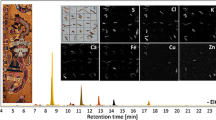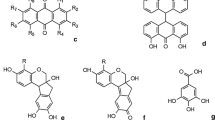Abstract
Samples of four natural dyes from different organic families—natural madder (anthraquinonoid), curcuma (curcuminoid), saffron (carotenoid) and indigo (indigotic)—were analysed using a new procedure based on pyrolysis–gas chromatography/mass spectrometry (Py–GC/MS), which includes the on-line derivatisation of the natural dyes using hexamethyldisilazane (HMDS). In addition, a previous procedure involving the addition of a 10% H2SO4 aqueous solution to the dye and further separation with ethyl acetate has been tested. This procedure enhances the sensitivity of the method by extracting the colouring compounds from the rest of the compounds present in the natural dye. Two possible derivatising reagents—HMDS and tetramethylammonium hydroxide (TMAH)—were compared in order to assess their effectiveness in the proposed method. Characteristic peaks from trimethylsilyl derivatives of alizarin, quinizarin, xanthopurpurin and purpurin were obtained for madder; peaks from safranal, isophorone and trimethylsilyl derivative of crocetin for saffron; peaks from 4-(4-hydroxy-3-methoxy)phenyl-3-buten-2-one and 4-(4-hydroxy-3-methoxy)phenyl-2-butanone, which are primary pyrolysis products of curcuma, and peaks from indole, 2-methylindole and 2,3-dihydroindol-2-one, which are primary pyrolysis products of indigo, among others, were obtained. The reported procedure leads to the unambiguous identification of the four studied dyes from solid samples formed by individual dyes.

Similar content being viewed by others
References
Low MJD, Baer NS (1977) Stud Conserv 22:116–128
Shearer JC, Peters DC, Hoepfner DC, Newton T (1983) Anal Chem 55:874A–880A
Taylor GW (1983) Stud Conserv 28:153–160
Edwards HGM, Farwell DW, Quye AJ (1997) Raman Spectrosc 28:243–249
Bell SEJ, Bourguignon ESO, Dennis AC, Fields JA, McGarvey JJ, Seddon KR (1999) Anal Chem 72:234–239
Edwards HGM, De Oliveira LFC, Nesbitt M (2003) Analyst 128:82–87
Vandenabeele P, Moens L (2003) Analyst 128:187–193
Guichard V, Guineau B (1990) Identification de colorants organiques naturels dans des fragments de peintures murales de l’Antiquité. CNRS, Paris
Miliani C, Romani A, Favaro G (1998) Spectrochim Acta A 54A:581–588
Doménech-Carbó A, Doménech-Carbó MT, Sauri-Peris MC, Gimeno-Adelantado JV, Bosch-Reig F (2003) Anal Bioanal Chem 375:1169–1175
Grygar T, Kucková S, Hradil D, Hradilová D (2003) J Solid State Electrochem 7:706–713
Scott DA, Khandekar N, Schilling MR, Turner N, Taniguchi Y, Khanjian H (2001) Stud Conserv 43:93–108
Hofenk de Graaff JH, Roelofs WGTh (1990) Natural dyestuffs; history of technology and scientific research. In: Pigments and dyes of antiquity and the Middle Ages. CNRS, Paris, pp 217–226
Nowik W (1996) Analusis 24:37–40
Orska-Gawrys J, Surowiec I, Kehl J, Rejniak H, Urbaniak-Walczak K, Trojanowicz M (2003) J Chromatogr A 989:239–248
Szostek B, Orska-Gawrys J, Surowiec I, Trojanowicz M (2003) J Chromatogr A 1012:179–192
Puchalska M, Orlinska M, Ackacha MA, Polec-Pawlak K, Jarosz M (2003) J Mass Spectrom 38:1252–1258
Ackacha MA, Polec-Pawlak K, Jarosz M (2003) J Sep Sci 26:1028–1034
Quye A, Wouters J, Boon JJ (1998) Preprints of 11th Triennial Meeting of ICOM Committee for Conservation, 1–6 September 1996, Edinburgh, UK, vol 2, pp 704–713
Henriksen LM, Kjøsen H (1983) J Chromatogr 258:252–257
Fabbri D, Chiavari G, Ling H (2000) J Anal Appl Pyrol 56:167–178
Chiavari G, Fabbri D, Prati S (2001) J Chromatogr A 922:235–241
Chiavari G, Fabbri D, Prati S (2001) Chromatographia 53:311–314
Chiavari G, Fabbri D, Prati S (2001) Anal Chim Acta 449:271–280
Prati S, Smith S, Chiavari G (2004) Chromatographia 59:227–231
Gettens RJ, Stout GL (1966) Painting materials. a short encyclopedia. Dover Publications Inc., New York
Matteini M, Moles A (1989) La Chimica nel Restauro. I materiali dell’arte pittorica. Nardini, Firenze
Cennini C (1988) El libro del arte. Akal, Madrid
Mills JS, White R (1987) The organic chemistry of museum objects. Butterworths, London
Bender M (1947) J Chem Educ 24:2–15
Hiscox GD, Hopkins AA (1997) El recetario industrial G. Gili, México
Mayer R (1993) The artist’s handbook of materials and techniques, 2nd edn. Hermann Blume, Madrid
Palomino A (1947) El museo pictórico y escala óptica. Aguilar, Madrid
Leonardo da Vinci (1995) Tratado de Pintura, 3rd edn. Akal, Madrid, pp 426–429
Turco A (1996) Coloritura, verniciatura e laccatura del legno. 3rd edn. Hoepli, Milano
Lampe V, Milobedzka J (1913) Ber Dtsch Chem Ges 46:2235; cited by Roughley PJ, Whiting DA (1971) Tetrahedron Lett 12:3471–3746
Kiuchi F, Goto Y, Sugimoto N, Akao N, Kondo K, Tsuda Y (1993) Chem Pharm Bull 41:1640–1643
Kelkar NC, Sanjeev Rao B (1933) J Indian I Sci A 17A:7–15
Tarantilis PA, Polissiou M, Manfait M (1994) J Chromatogr 664:55–61
Iborra JL, Castellar MR, Canovas M, Manjón AJ (1992) Food Sci 57:714–716
Himeno H, Sano K (1987) Agr Biol Chem 51:2395–2400
Castellar MR, Montijano H, Manjón A, Iborra JL (1993) J Chromatogr 648:187–190
Tarantilis PA, Tsoupras G, Polissiou M (1995) J Chromatogr 699:107–118
Kuroda KI (2000) J Appl Pyrol 56:79–87
Tarantilis PA, Polissiou MG (1997) J Agr Food Chem 45:459–462
De Leeuw J, Baas M (1993) J Appl Pyrol 26:175–184
Tegelaar EW, De Leeuw J, Holloway PJ (1989) J Appl Pyrol 15:289–295
Acknowledgements
Financial support is gratefully acknowledged from the “I+D+I MCYT” Project BQU2001-2776-C03-01 and “Generalitat Valenciana I+D” Project GV04B-441.
Author information
Authors and Affiliations
Corresponding author
Electronic Supplementary Material
Rights and permissions
About this article
Cite this article
Casas-Catalán, M.J., Doménech-Carbó, M.T. Identification of natural dyes used in works of art by pyrolysis–gas chromatography/mass spectrometry combined with in situ trimethylsilylation. Anal Bioanal Chem 382, 259–268 (2005). https://doi.org/10.1007/s00216-005-3064-0
Received:
Revised:
Accepted:
Published:
Issue Date:
DOI: https://doi.org/10.1007/s00216-005-3064-0




